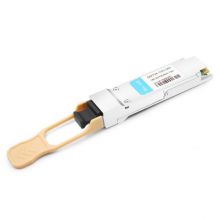
After years of development, 100G applications have formed a variety of technology types and alliances, whether it is the standardized ieee802.3bm or the 100G application model launched by SWDM, MSA and other organizations. There are many kinds of interfaces and application technologies supporting 100G, and each has its own characteristics. For the practical application of the data center, the distance between the connection points of most data centers does not exceed 500 meters. From a large number of 100G interface models, we have selected four types that are most likely to be used in data centers for further analysis for users who need to deploy 100G for reference. 1. 100GBase-SR4 100GBase-SR4 complies with the new standard ieee802.3bm issued in 2015. It uses 4 channels composed of 8-core multimode fiber for parallel transmission. Both multimode OM3 and OM4 optical fibers support 100G applications. The interface adopts 12 core MPO interface. The middle four core optical fiber does not need to be used. Each channel supports 25G. The transmission model is completely consistent with 100GBase-SR4 in ieee802.3ba. The optical transceiver adopts 100G QSFP28 SR4. This model can use conventional OM3 and OM4 multimode optical fibers to support 70m and 100m distances of 100G applications respectively. 2. 100GBase-SWDM4 SWDM (Short Wavelength Division Multiplexing) transmits four wavelength bands of optical signals over a single core of multimode fiber. The principle of WDM is similar to CWDM on single-mode, but SWDM is the first application of WDM technology on the short wavelength band of multimode fiber. It can be referred to the transmission principle model in the following figure: The main transmission window of traditional OM3 and OM4 multimode fiber is defined at 850nm. If SWDM technology is adopted, four windows are required to transmit optical signals, and the four wavebands still use VCSEL vertical cavity surface emitting lasers with high cost performance. In order to improve the overall bandwidth, the bandwidth of the new generation multimode fiber WBMMF(Wideband Multimode Fiber) is increased. In WBMMF, the highest bandwidth performance is around 880nm band, and the highest bandwidth point is higher than that of traditional OM4 multimode fiber. The SWDM technology can also use OM4 optical fiber as the transmission medium, but the transmission distance should be reduced accordingly. Compared with the SR4 model, SWDM4 requires only 25% of the optical fiber.3. 100GBase-PSM4 100GBase-PSM4 adopts single-mode optical fiber parallel transmission mode. Each 100G model adopts 8-core single-mode optical fiber to form four independent channels. The interface adopts 12 core MPO interface, in which the middle 4-core optical fiber of MPO interface is not enabled, and each channel supports 25G. The optical fiber transmission model is similar to 100GBase-SR4. The biggest difference is that PSM4 adopts single-mode optical fiber as the transmission medium and laser light source 1310 window. The optical transceiver also adopts QSFP28, and the connector adopts MTP / MPO single-mode APC. At present, 100GBase PSM4 has not been recognized by IEEE standardization organization, and is mainly promoted by PSM4 MSA alliance. 4. 100GBase-CWDM4 100GBase-CWDM4 is a 100G transmission model based on single-mode coarse wavelength division multiplexing(CWDM) technology. The fiber optic transceiver uses a single-mode laser light source with LC duplex interface, and supports four long wavelength bands of signal transmission on each core fiber, these four emission windows are 1271nm,1291nm,1311nm,1331nm, and each band transmits 25G. 100GBase-CWDM4 model is also used QSFP28 optical transceiver.Compare to traditional single-mode 10KM transceiver with high cost, the 2KM QSFP28 100G CWDM4 transceiver has a competitive price. 5. Summary Different types of data centers determine different needs. Not all data center users currently have the need to deploy 100G, so what types of users need to deploy 100G networks the most? To answer this question, we can divide data centers into two major categories, IDC (Internet Data Center) and EDC (Enterprise Data Center). Relatively speaking, some IDC data centers have more urgency to deploy 100G backbone networks, such as the data centers of large interconnection companies or carriers or some scaled cloud computing data centers. In terms of current price, although the wiring cost of multi-mode 100G based on SR4 is relatively high, the overall price has certain advantages, especially the price of SR4 optical transceiver is significantly lower than that of other types. Meanwhile, the price of optical transceiver based on CWDM single-mode is significantly higher than that of the other three types. The overall price difference between PSM4 and SWDM is small. As the SWDM alliance participated by a small number of optical transceiver manufacturers, it is not a public technology at present, and the market price remains relatively high temporarily. However, from the perspective of technology and cost composition, there is still a large room for price decline of SWDM, and this product has a certain market potential in the future.
Optical Transceiver QSFP28 100G QSFP28 3393 101 07/29/21RECENT POSTS
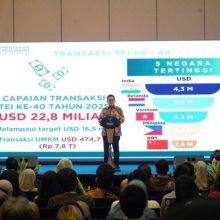
Minister of Trade Budi Santoso: Transactions Surpass Target, Reaching USD 22.80 Billion TANGERANG, Indonesia, Oct. 23, 2025 /PRNewswire/ -- Minister of Trade Budi Santoso officially closed the 40th Trade Expo Indonesia (TEI) 2025 at the Indonesia Convention Exhibition (ICE), BSD, Tangerang Regency, Banten, on Sunday (19/10). As of 1:00 p.m. local time on the closing day, the country's largest export exhibition recorded an outstanding achievement, with total transactions reaching USD 22.80 billion, equivalent to IDR 376.20 trillion, exceeding the initial target of USD 16.5 billion. Minister of Trade Budi Santoso delivers a presentation on the results of the 40th Trade Expo Indonesia (TEI) 2025, highlighting total transactions of USD 22.8 billion over five days, exceeding the set target and marking a record achievement in Indonesia’s export performance. "As of 1:00 p.m. today, total transactions have reached USD 22.80 billion and are expected to continue growing beyond USD 23 billion. This achievement demonstrates that Indonesian products not only compete globally but have also become top choices in the international market. The 40th TEI highlights Indonesia's natural and human resource strengths in producing high-quality and sustainable export products," stated Minister Budi Santoso. Throughout the five-day exhibition, TEI 2025 welcomed 34,550 visitors from 131 countries, surpassing the target of 30,000 visitors. Of these, 8,045 were international buyers representing 130 countries, with the largest contingents from Malaysia (769 buyers), China (605), India (594), Nigeria (509), and Egypt (406). The exhibition featured 1,619 participating companies, exceeding the target of 1,500. Participants included 623 companies in the Food, Beverages & Agricultural Products, Licensing and Franchise Zone; 603 companies in the Fashion & Lifestyle Zone; and 393 companies in the Manufacturing and Services Zone. In terms of trade performance, goods transactions reached USD 17.90 billion, services USD 443.70 million, and investment USD 4.37 billion. These transactions comprised MoUs worth USD 22.70 billion, fairground transactions amounting to USD 71.60 million, and business matching deals worth USD 63.40 million, an 88% increase compared to 2024. Notably, micro, small, and medium enterprises (MSMEs) contributed USD 474.70 million (approximately IDR 7.80 trillion) in transactions. Among participating countries, India led with USD 4.30 billion in transaction value, followed by the Netherlands (USD 3.90 billion), Vietnam (USD 3.30 billion), the Philippines (USD 3.10 billion), and China (USD 2.40 billion). The most sought-after products included mining products (USD 5.50 billion), precious metals (USD 2.70 billion), palm oil and derivatives (USD 2.30 billion), charcoal and briquettes (USD 1.60 billion), and spare parts (USD 1.40 billion). In addition to the main exhibition, Pangan Nusa Expo 2025 also achieved notable success, generating USD 7.30 million in potential international culinary expansion deals, IDR 37.60 billion in business matching opportunities, and IDR 2.40 billion in on-the-spot transactions. The event provided market access for 12 culinary MSMEs, including winners of the UKM Pangan Award, to modern retail and national transportation networks such as PT KAI. Minister Santoso extended his appreciation to all contributors, including trade representatives abroad, Trade Attachés (Atdag), Indonesia Trade Promotion Centers (ITPC), Indonesian Trade and Economic Offices (KDEI), Trade Consuls, and Ambassadors in partner countries. He also expressed gratitude to supporting ministries and agencies, PT Bank Mandiri (Persero), PT Debindo Multi Adhiswasti as the event organizer, and PT Pertamina along with the Badan Pengelola Dana Perkebunan (BPDP) as key partners. "The success of the 40th TEI is the result of strong collaboration among the government, business community, banking sector, state-owned enterprises, and other strategic partners. Let us continue this momentum to further enhance the quality and competitiveness of Indonesia's non-oil and gas exports," Minister Santoso emphasized. Minister Santoso also announced that the 41st Trade Expo Indonesia will be held from October 14–18, 2026, encouraging all stakeholders to pursue continuous innovation, improve product quality, harness digital technology, and uphold sustainable business practices. "Keep innovating, elevate your product quality, and leverage digital technology. Stay passionate, the world awaits the finest products from Indonesia," concluded Minister Santoso. The 40th Trade Expo Indonesia is Organized by PT Debindomulti Adhiswasti. PR Newswire is the media partner of the 40th Trade Expo Indonesia (TEI) 2025
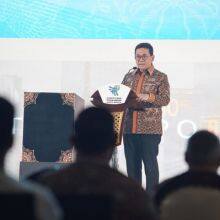
TANGERANG, Indonesia, Oct. 23, 2025 /PRNewswire/ -- Minister of Trade Budi Santoso, accompanied by Coordinating Minister for Food Affairs Zulkifli Hasan, officially inaugurated the 40th Trade Expo Indonesia (TEI) 2025 at the Indonesia Convention Exhibition (ICE) BSD City, Tangerang Regency, Banten, on Wednesday (15/10). The annual international-scale exhibition organized by the Ministry of Trade of the Republic of Indonesia carries the theme "Discover Indonesia's Excellence: Trade Beyond Boundaries." Minister of Trade Budi Santoso delivers his keynote address during the opening ceremony of the 40th Trade Expo Indonesia (TEI) 2025. The event marks Indonesia’s ongoing commitment to strengthening global trade partnerships and showcasing the nation’s world-class export products. In his remarks, Coordinating Minister Zulkifli Hasan, representing President Prabowo Subianto, emphasized that the government's trade policies remain on the right track, as reflected in Indonesia's strong and consistent export performance. "As of this month, Indonesia's national export value has grown by more than 7 percent compared to last year, with the trade surplus increasing to USD 29 billion. This remarkable achievement is the result of collective effort and collaboration. Through the spirit of partnership and optimism, Indonesia will continue to strengthen its position as a highly competitive economic power in the global market," stated Minister Zulkifli Hasan. Meanwhile, Minister of Trade Budi Santoso reported that TEI 2025 features 1,619 exhibitors and has successfully registered 8,045 buyers from 130 countries. The exhibition is divided into three main zones, Food & Agricultural Products, Manufacturing Products, and Services & Lifestyle, with total transaction targets reaching USD 16.5 billion. "TEI serves as a tangible reflection of President Prabowo's Asta Cita vision, reinforcing national downstream industrialization and expanding Indonesia's role in the global value chain toward the Golden Indonesia 2045," said Minister Santoso. He added that beyond the main exhibition, the 40th TEI also features a series of supporting programs such as business matching, business counseling, and various business forums aimed at fostering partnerships and expanding global market access. Minister Santoso extended his appreciation and gratitude to all stakeholders for their cooperation and support. Special acknowledgments were given to the Ministry of Foreign Affairs, Indonesian representatives abroad, foreign embassies in Indonesia, the Indonesian Chamber of Commerce and Industry (KADIN), and foreign chambers of commerce that actively contributed to engaging international buyers and expanding Indonesia's trade network globally. He also expressed appreciation to the main sponsors, Bank Mandiri, Pertamina, and the Palm Oil Plantation Fund Management Agency (BPDPKS) for their continuous support and participation in ensuring the success of the 40th TEI. Gratitude was also conveyed to all ministries and agencies, local governments, state-owned enterprises (SOEs), private partners, and PT Debindo Multi Adhiswasti as the event organizer for their valuable contributions. "Through the spirit of collaboration and optimism that we build together, I am confident that Indonesia will continue to solidify its position as a highly competitive economic power in the global market for the prosperity of our nation and the well-being of the global community," Minister Santoso concluded. During the opening ceremony, Minister Santoso also presented the Primaniyarta Awards to top-performing exporters and regional leaders who have consistently increased their export value and global brand recognition. Awards were also given to pioneering exporters in new markets who serve as inspiration for Indonesia's export community. Additionally, the Primaduta Awards were presented to loyal buyers and Indonesia's long-term export partners. The recognition also extended to Indonesian trade representatives abroad for their efforts in promoting the country's non-oil and gas exports. Distinguished guests attending the opening included Minister for Micro, Small, and Medium Enterprises (MSMEs) Maman Abdurrahman, Minister for Villages and Underdeveloped Regions Yandri Susanto, Governor of Banten Andra Soni, and Chairman of KADIN Indonesia Anindya Bakrie. Also in attendance were Francisco Kalbuady Lay, Deputy Prime Minister and Coordinating Minister for Economic Affairs of the Democratic Republic of Timor-Leste; Salem Mohamed Ahmed Salman, Deputy Minister of Trade and Industry of Yemen; and Hossam Heiba, Chairman of the General Authority for Investment and Free Zones of Egypt; along with Indonesian ambassadors and foreign ambassadors from partner countries. The 40th Trade Expo Indonesia is Organized by PT Debindomulti Adhiswasti. PR Newswire is the media partner of the 40th Trade Expo Indonesia (TEI) 2025
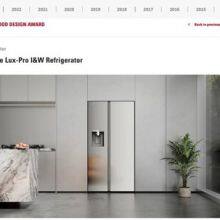
SUZHOU, China, Oct. 23, 2025 /PRNewswire/ -- Dreame Technology's innovative Sparkling Water Refrigerator has been honored with the prestigious Japan Good Design Award, often called the "Oscar of Eastern Design." The award recognizes its design philosophy of "Seamless Integration of Technology and Aesthetics," marking a significant international endorsement of its innovative design and user experience. Dreame's Sparkling Water Refrigerator Honored with Japan Good Design Award The Dreame Sparkling Water Refrigerator goes beyond traditional home appliance design by integrating three core functions: Instant Sparkling Water, Smart Freshness, and Home Aesthetics. This integration offers a one-stop solution for modern kitchens. The refrigerator features an instant sparkling water system, supporting three levels of carbonation to meet various beverage pairing needs. The IceDUO Auto Ice Maker offers both cube ice and crushed ice, paired with a high-capacity ice box, easily catering to high-frequency household ice usage scenarios. In terms of preservation, the refrigerator features a Twin-Cooling system that effectively prevents odor transfer. Its HumidFlex intelligent humidity control zone accurately maintains optimal humidity levels for various foods. The user-centric spatial design includes a dedicated snacks zone for canned goods and an adjustable wine rack, achieving a perfect balance of practicality and visual order. The exterior utilizes an anti-fingerprint MatteSilk stainless steel panel. Combined with EU high energy efficiency certification and 35dB ultra-quiet operation, it realizes aesthetic expression while also adhering to concepts of energy saving and low noise for the home. This award highlights Dreame's leadership in product design and technology integration, accelerating its global expansion. Moving forward, Dreame will remain dedicated to user-centric innovation, pioneering a new era of smarter, more integrated high-end home appliances. The article is from Shuzhi Society
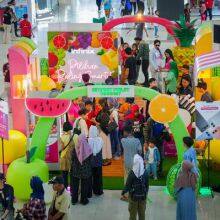
A fusion of art, AI, and playful learning brings warmth, imagination, and human connection into technology, showing how creativity turns everyday moments into inspiring experiences. HONG KONG, Oct. 23, 2025 /PRNewswire/ -- Infinix is exploring new ways for young consumers to connect with technology through its imaginative campaign "SMART Fruit Market" in Indonesia. The initiative turns daily life into a space for creativity, combining AI-generated artistry, interactive learning, and human-centered storytelling. Visitors explore one of the Infinix “SMART Fruit Market” pop-ups in Indonesia, an interactive space that blends art, AI, and creativity to inspire smarter technology choices. Based on insight into how young people experience technology, Infinix takes a different approach from traditional tech marketing by adding warmth, wit, and deeper consumer insights to its communications. "The SMART Fruit Market reflects how Infinix blends cultural insight with creative imagination to craft storytelling with warmth and relevance," said TT Liu, Chief Marketing Officer of Infinix. "We aim to use creativity, education, and interaction as bridges to bring technology closer to life, inspiring young people around the world to explore infinite possibilities for the future." A Creative Fusion of Art and Technology Infinix unveiled a series of AI-generated shorts that reimagine the perspectives of history's most influential thinkers and artists, each portrayed in a distinct creative setting with their own playful "fruit-picking philosophy." Through witty dialogue and visual metaphor, the shorts illustrate how everyday decisions can mirror the way consumers make smarter, value-driven technology choices. Rule 1: "Color Makes Freshness Obvious."Rule 2: "High Prices Do Not Always Mean Higher Value."Rule 3: "You Need Greater Energy."Rule 4: "The Best Always Look Alike." Blending everyday humor with relatable insight, the campaign turns fruit-picking into a metaphor for mindful decision-making in technology. By connecting familiar life moments with creative storytelling, the shorts bridge art, science, and daily life—reflecting Infinix's belief that technology should spark creativity, foster connection, and bring warmth to innovation. Building on this idea, Infinix brought the concept offline through the SMART Fruit Market pop-up, where visitors experienced the four principles via interactive installations, learning zones, and themed photo spaces featuring the Infinix SMART 10 Plus. The activation drew more than 8,000 visitors across Jakarta, Bandung, and Surabaya, generating strong engagement and positive audience feedback. Humanizing Technology through Everyday Insight Through consumer insight, Infinix found that young people seek innovation with a human touch. The brand moves beyond product-centric communication by weaving technology into daily life through storytelling that feels intuitive, emotional, and inspiring. This approach turns innovation into a human-centered experience, encouraging people to see technology not merely as a tool but as part of their lifestyle and creativity. From Supermarket Aisles to Immersive Spaces The campaign began in late September as a "Fruit Stall" activation inside Super Indo supermarkets in Jakarta. Among fresh-fruit displays, shoppers discovered smartphones accompanied by the same four playful selection principles, helping audiences evaluate technology with clarity and confidence. Shoppers get to experience the Infinix “SMART Fruit Market” inside Super Indo supermarkets, turning fruit picking into a creative tech encounter. Visitors explore the Infinix “SMART Fruit Market” pop-up in Surabaya, Indonesia, blending art, AI, and creativity to inspire smarter choices. Encouraged by the strong response, Infinix expanded the idea into a larger, immersive SMART Fruit Market pop-up. Participants joined the "Trade Your Apple" challenge for opportunities to win vouchers, merchandise, and the SMART 10 Plus smartphone—turning fruit picking into an interactive learning experience that linked technology with everyday culture. "We turned a simple fruit-shopping idea into an interactive learning experience," said Sergio Ticoalu, Head of Marketing, Infinix Indonesia. "This campaign connects technology to daily life and shows that making smart choices can be enjoyable." Visitors take part in interactive activities at the Infinix “SMART Fruit Market” pop-up event, blending play and creativity with technology. Continuing to Build Insight-Driven Creative Campaigns Following the campaign's success in Indonesia, Infinix will continue developing insight-driven creative strategies across global markets. Through collaborations with local communities and creative partners, the brand aims to create emotionally resonant experiences that bring warmth and inspiration to smart technology for consumers around the world. About Infinix Established in 2013, Infinix is an innovation-driven brand dedicated to delivering cutting-edge technology, bold design, and outstanding performance. The brand provides smart, enjoyable mobile experiences that enhance everyday life. Beyond smartphones, Infinix has expanded its portfolio to include TWS earbuds, smartwatches, laptops, tablets, smart TVs, and more—building a comprehensive ecosystem of smart devices. Currently, Infinix products are available in over 70 countries and regions worldwide, including Africa, Latin America, the Middle East, South Asia, and Southeast Asia. For more information, please visit www.infinixmobility.com.


